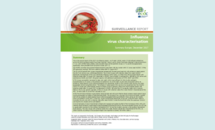Influenza virus characterisation, Summary Europe, March 2018
This is the fourth report of the 2017–18 influenza season. The ECDC Influenza Virus Characterisations Reports are published periodically. The report provides an overview of the technical details of the circulating influenza viruses, such as antigenic and genetic properties, with a reference to the current vaccine strains. It also summaries the developments of the viruses since the last report, as well as the main developments for the ongoing season. The report is of special interest for influenza virologists and epidemiologists interested in the in-depth characterisation of influenza viruses.
Executive Summary
This is the fourth report of the 2017–18 influenza season. As of week 13/2018, over 217 000 influenza detections across the WHO European Region have been reported. Types A and B viruses have been detected in the proportions 42% and 58%, respectively, with A(H1N1)pdm09 viruses now being slightly more prevalent than A(H3N2) (1:0.96), and B/Yamagata being significantly more prevalent than B/Victoria viruses (48.7:1).
Twenty-nine EU/EEA countries have shared influenza-positive specimens with the London WHO CC, Crick Worldwide Influenza Centre (WIC), since week 40/2017, with 984 specimens having collection dates after August 2017.
The 36 A(H1N1)pdm09 test viruses characterised antigenically showed good reactivity with antiserum raised against the 2017–18 vaccine virus, A/Michigan/45/2015. The 133 test viruses with collection dates from week 40/2017 genetically characterised at the WIC, as others from the WHO European Region with collection dates after 31 August 2017 deposited in GISAID (Global Initiative on Sharing All Influenza Data), all fell in subclade 6B.1, defined by HA1 amino acid substitutions S162N and I216T, the great majority with additional substitutions of S74R, S164T and I295V.
Of 191 A(H3N2) viruses successfully recovered to date, only 32 (17%) had sufficient HA titre to allow antigenic characterisation by HI assay in the presence of oseltamivir. The majority of these 32 viruses were poorly recognised by antisera raised against the currently used vaccine virus, egg-propagated A/Hong Kong/4801/2014, in HI assays. Of the 225 viruses with collection dates from week 40/2017 genetically characterised at the WIC, 154 were clade 3C.2a (with 129 3C.2a2, 21 3C.2a3 and four 3C.2a4), 68 fell within clade 3C.2a1 (with two 3C.2a1a and 65 3C.2a1b) and three were clade 3C.3a.
A single B/Victoria-lineage viruses was tested by HI and it reacted well with only one of the panel of post-infection ferret antisera; this antiserum was raised against tissue culture-propagated B/Norway/2409/2017, a virus with a deletion of two amino acids in HA1 (Δ162-163). Of the 29 viruses characterised genetically at the WIC with a collection date after week 40/2017, ten fell within clade 1A, and 19 fell within the subgroup carrying the HA1 double amino acid deletion.
A total of 45 B/Yamagata viruses were characterised antigenically and 98% reacted well (within fourfold of the homologous titre) with post-infection ferret antiserum raised against egg-propagated B/Phuket/3073/2013, the recommended vaccine virus for use in quadrivalent vaccines for the northern hemisphere 2017–18 and 2018–2019 seasons and for trivalent vaccines in the southern hemisphere 2018 season. The 180 viruses with collection dates from week 40/2017 genetically characterised
Download

See all reports
More about seasonal influenza
Disease page
Seasonal influenza
Seasonal influenza is a preventable infectious disease with mostly respiratory symptoms. It is caused by influenza virus and is easily transmitted, predominantly via the droplet and contact routes and by indirect spread from respiratory secretions on hands etc.
European Influenza Surveillance Network (EISN)
The network combines epidemiological and virological surveillance of influenza.
Objectives for integrated surveillance of respiratory viruses at EU level
There are general objectives for integrated surveillance of respiratory viruses in the European Union. These objectives apply to surveillance of influenza, COVID-19, and other respiratory virus infections.
Surveillance for seasonal influenza
Epidemiological and virological data from the EU/EEA Member States. The surveillance data reported comes largely from sentinel influenza surveillance systems.




